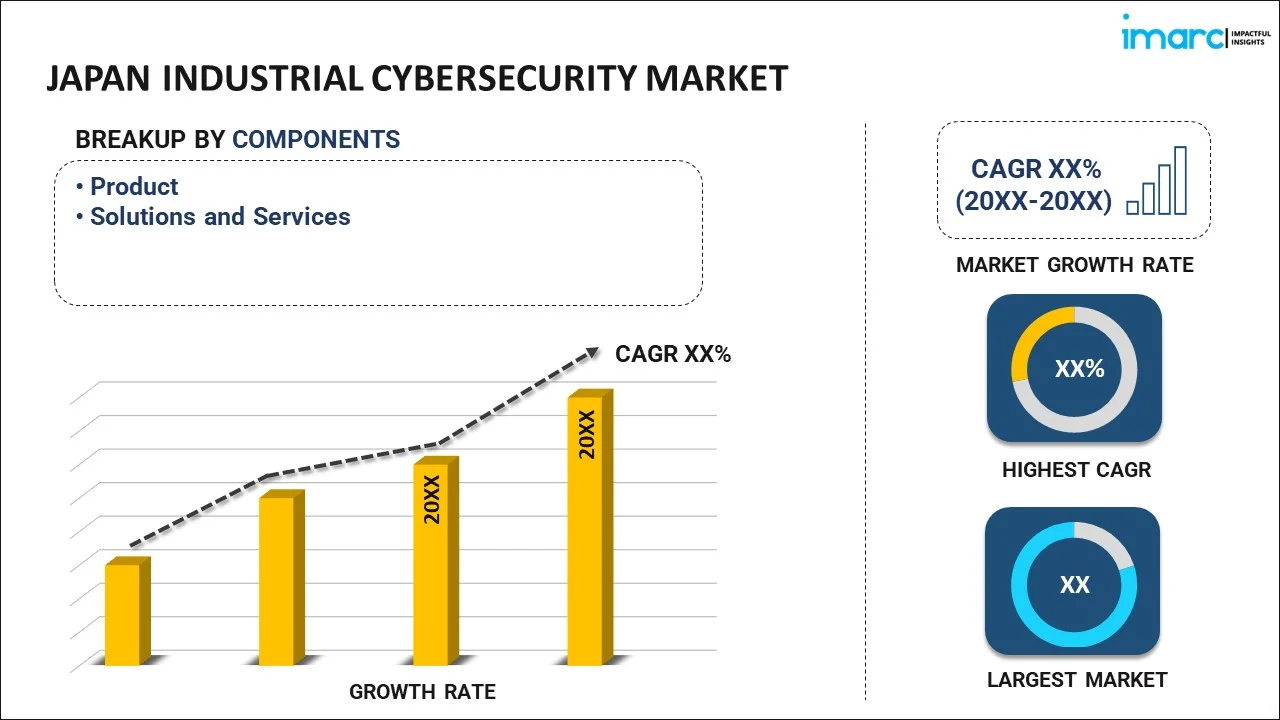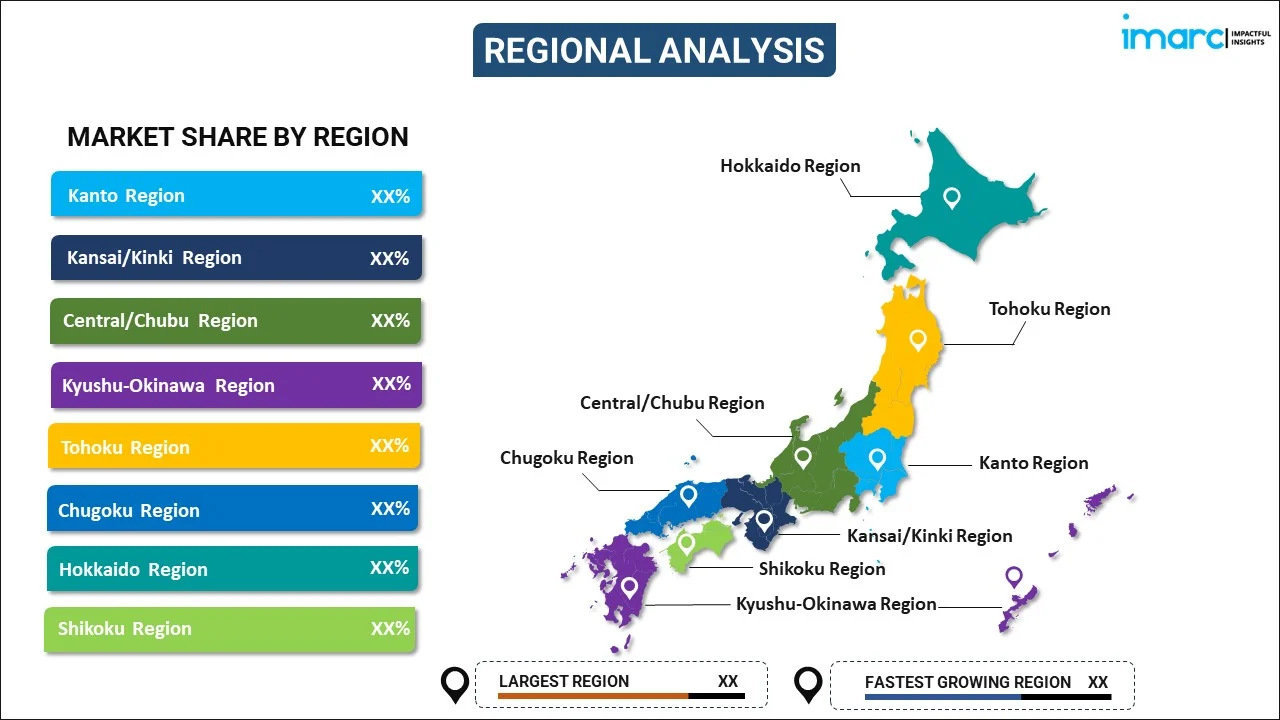
Japan Industrial Cybersecurity Market Report by Component (Product, Solutions and Services), Security Type (Network Security, Cloud Application Security, End-Point Security, Internet Security, and Others), Industry (Process, Discrete), and Region 2025-2033
Market Overview:
Japan industrial cybersecurity market size reached USD 18,000 Million in 2024. Looking forward, IMARC Group expects the market to reach USD 43,300 Million by 2033, exhibiting a growth rate (CAGR) of 10.3% during 2025-2033. The growing usage of artificial intelligence (AI) and machine learning (ML) technologies, along with the widespread adoption of cloud-based solutions, is primarily driving the market growth.
|
Report Attribute
|
Key Statistics
|
|---|---|
|
Base Year
|
2024 |
|
Forecast Years
|
2025-2033
|
|
Historical Years
|
2019-2024
|
| Market Size in 2024 | USD 18,000 Million |
| Market Forecast in 2033 | USD 43,300 Million |
| Market Growth Rate (2025-2033) | 10.3% |
Industrial cybersecurity encompasses the safeguarding of industrial control systems (ICS) and critical assets against cyber threats. This entails the implementation of a range of security measures, including but not limited to access control, network security, endpoint protection, incident detection and response, vulnerability management, monitoring, and data security. Its primary purpose is to ensure the security of various vital sectors such as power distribution, manufacturing facilities, automation systems, healthcare infrastructure, communication networks, defense production facilities, critical installations, and transportation systems. Additionally, industrial cybersecurity plays a vital role in addressing vulnerabilities, enforcing appropriate security controls, safeguarding national security interests, and reducing the risk of industrial accidents. Consequently, industrial cybersecurity is widely applied across a diverse range of industries including automotive, transportation, aerospace, defense, chemical, oil and gas, manufacturing, and telecommunications.
Japan Industrial Cybersecurity Market Trends:
The Japan industrial cybersecurity market is experiencing significant growth, primarily driven by the escalating frequency of cyberattacks and threats targeting critical infrastructures. Moreover, the rapid expansion of the Industrial Internet of Things (IIoT) landscape, aimed at enhancing operational efficiency, is fueling the demand for robust industrial cybersecurity solutions. In addition to this, the market is benefiting from the increasing preference for cloud-based solutions. These cloud solutions offer several advantages, such as improved scalability, accessibility, security, automatic updates, disaster recovery capabilities, and real-time data processing, which are contributing to their popularity. Furthermore, the integration of artificial intelligence (AI) and machine learning (ML) techniques in cybersecurity measures is bolstering the market's growth. The adoption of blockchain technology is another positive factor influencing market growth. This technology enhances the security of critical transactions, supply chain operations, and data sharing. Additionally, stringent government regulations promoting the adoption of cybersecurity solutions across industries and fortifying the security of critical infrastructures vital to the nation's economy are providing further impetus to the market. Moreover, factors like rapid digitalization efforts, increased investments in advanced cybersecurity solutions, and growing awareness of the detrimental consequences of cyber threats are expected to continue driving the expansion of the Japan industrial cybersecurity market over the forecasted period.
Japan Industrial Cybersecurity Market Segmentation:
IMARC Group provides an analysis of the key trends in each segment of the market, along with forecasts at the country level for 2025-2033. Our report has categorized the market based on component, security type, and industry.
Component Insights:

- Product
- Solutions and Services
The report has provided a detailed breakup and analysis of the market based on the component. This includes product and solutions and services.
Security Type Insights:
- Network Security
- Cloud Application Security
- End-Point Security
- Internet Security
- Others
A detailed breakup and analysis of the market based on the security type have also been provided in the report. This includes network security, cloud application security, end-point security, internet security, and others.
Industry Insights:
- Process
- Oil and Gas
- Chemical
- Food and Beverages
- Energy and Power
- Others
- Discrete
- Automotive
-
- Electronics
- Heavy Manufacturing
- Packaging
- Others
The report has provided a detailed breakup and analysis of the market based on the industry. This includes process (oil and gas, chemical, food and beverages, energy and power, and others), and discrete (automotive, electronics, heavy manufacturing, packaging, and others).
Regional Insights:

- Kanto Region
- Kansai/Kinki Region
- Central/ Chubu Region
- Kyushu-Okinawa Region
- Tohoku Region
- Chugoku Region
- Hokkaido Region
- Shikoku Region
The report has also provided a comprehensive analysis of all the major regional markets, which include Kanto Region, Kansai/Kinki Region, Central/ Chubu Region, Kyushu-Okinawa Region, Tohoku Region, Chugoku Region, Hokkaido Region, and Shikoku Region.
Competitive Landscape:
The market research report has also provided a comprehensive analysis of the competitive landscape. Competitive analysis such as market structure, key player positioning, top winning strategies, competitive dashboard, and company evaluation quadrant has been covered in the report. Also, detailed profiles of all major companies have been provided.
Japan Industrial Cybersecurity Market Report Coverage:
| Report Features | Details |
|---|---|
| Base Year of the Analysis | 2024 |
| Historical Period | 2019-2024 |
| Forecast Period | 2025-2033 |
| Units | Million USD |
| Scope of the Report | Exploration of Historical Trends and Market Outlook, Industry Catalysts and Challenges, Segment-Wise Historical and Future Market Assessment:
|
| Components Covered | Product, Solutions and Services |
| Security Types Covered | Network Security, Cloud Application Security, End-Point Security, Internet Security, Others |
| Industries Covered |
|
| Regions Covered | Kanto Region, Kansai/Kinki Region, Central/ Chubu Region, Kyushu-Okinawa Region, Tohoku Region, Chugoku Region, Hokkaido Region, Shikoku Region |
| Customization Scope | 10% Free Customization |
| Post-Sale Analyst Support | 10-12 Weeks |
| Delivery Format | PDF and Excel through Email (We can also provide the editable version of the report in PPT/Word format on special request) |
Key Questions Answered in This Report:
- How has the Japan industrial cybersecurity market performed so far and how will it perform in the coming years?
- What has been the impact of COVID-19 on the Japan industrial cybersecurity market?
- What is the breakup of the Japan industrial cybersecurity market on the basis of component?
- What is the breakup of the Japan industrial cybersecurity market on the basis of security type?
- What is the breakup of the Japan industrial cybersecurity market on the basis of industry?
- What are the various stages in the value chain of the Japan industrial cybersecurity market?
- What are the key driving factors and challenges in the Japan industrial cybersecurity?
- What is the structure of the Japan industrial cybersecurity market and who are the key players?
- What is the degree of competition in the Japan industrial cybersecurity market?
Key Benefits for Stakeholders:
- IMARC’s industry report offers a comprehensive quantitative analysis of various market segments, historical and current market trends, market forecasts, and dynamics of the Japan industrial cybersecurity market from 2019-2033.
- The research report provides the latest information on the market drivers, challenges, and opportunities in the Japan industrial cybersecurity market.
- Porter's five forces analysis assist stakeholders in assessing the impact of new entrants, competitive rivalry, supplier power, buyer power, and the threat of substitution. It helps stakeholders to analyze the level of competition within the Japan industrial cybersecurity industry and its attractiveness.
- Competitive landscape allows stakeholders to understand their competitive environment and provides an insight into the current positions of key players in the market.
Need more help?
- Speak to our experienced analysts for insights on the current market scenarios.
- Include additional segments and countries to customize the report as per your requirement.
- Gain an unparalleled competitive advantage in your domain by understanding how to utilize the report and positively impacting your operations and revenue.
- For further assistance, please connect with our analysts.
 Inquire Before Buying
Inquire Before Buying
 Speak to an Analyst
Speak to an Analyst
 Request Brochure
Request Brochure
 Request Customization
Request Customization




.webp)




.webp)












